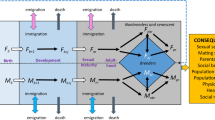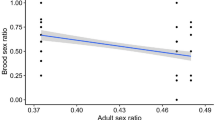Abstract
FISHER'S theory of sex-ratio evolution1 explains why 1:1 sex ratios are so prevalent2–8. Recent work has therefore emphasized situations in which biased sex ratios tend to evolve (for example, local mate competition7, non-mendelian inheritance of sex-ratio factors7,9,10, haplodiploid social insects11,12 and others6,13). In species where individuals change sex during their adult lifetimes, and in species where sex is determined by environmental conditions experienced during pre-adult development, biased sex ratios are expected and frequently observed6. Sex-ratio models for particular kinds of sex change (SC) and environmental sex determination (ESD) have predicted excesses of the first sex6,14,15 under SC, and of the sex developing in the 'worse' environment under ESD6,14–16. Here we generalize and unite these results in a single model that applies to a wide range of SC and ESD biologies. The principle that emerges from this model appears to explain strong female and male excesses seen in sex-changing fish and invertebrates and in nematodes with ESD. It is not known whether the female excess commonly seen in reptiles with ESD are also explained by this principle.
This is a preview of subscription content, access via your institution
Access options
Subscribe to this journal
Receive 51 print issues and online access
199,00 € per year
only 3,90 € per issue
Buy this article
- Purchase on SpringerLink
- Instant access to full article PDF
Prices may be subject to local taxes which are calculated during checkout
Similar content being viewed by others
References
Fisher, R. A. The Genetical Theory of Natural Selection (Clarendon, Oxford, 1930).
Maynard Smith, J. Evolution and the Theory of Games (Cambridge Univ. Press, Cambridge, 1982).
Shaw, R. F. & Mohler, J. D. Am. Nat. 87, 337–342 (1953).
Williams, G. C. Adaptation and Natural Selection (Princeton Univ. Press, Princeton, 1966).
Leigh, E. G. Oxford Surveys evol. Biol. 3, 187–223 (1986).
Charnov, E. L. The Theory of Sex Allocation (Princeton Univ. Press, Princeton, 1982).
Hamilton, W. D. Science 156, 477–488 (1967).
Bull, J. J. & Charnov, E. L. Oxford Surveys evol. Biol. 5, 96–135 (1988).
Lewis, D. New Phytologist 40, 56–63 (1941).
Howard, H. W. J. Genet 44, 143–159 (1942).
Hamilton, W. D. A. Rev. Ecol. Syst 3, 193–232 (1972).
Trivers, R. L. & Hare, H. H. Science 191, 249–263 (1976).
Karlin, S. & Lessard, S. Theoretical Studies on Sex Ratio Evolution (Princeton Univ. Press, Princeton, 1986).
Frank, S. A. & Swingland, I. S. J. theor. Biol. 135, 415–418 (1988).
Charnov, E. L. & Bull, J. J. J. theor. Biol. (in the press).
Bull, J. J. Heredity 46, 9–26 (1981).
Warner, R. R. Environmental Biology of Fishes Vol. 22, 81–90 (1988).
Warner, R. R. Trends Ecol. Evol. 3, 133–136 (1988).
Shapiro, D. Y. Science 209, 1136–1137 (1980).
Trivers, R. L. & Willard, D. E. Science 179, 90–92 (1973).
Bull, J. J. Evolution of Sex Determining Mechanisms (Benjamin/Cummings, Menlo Park, 1983).
Blackmore, M. S. thesis, Univ. Utah (1989).
Charnov, E. L. Am. Nat. 113, 715–734 (1979).
Charnov, E. L., Gotshall, D. & Robinson, J. Science 200, 204–206 (1978).
Ballantine, W. J. thesis, London Univ, (1961).
Hoagland, K. E. Malacologia 17, 365–391 (1978).
Robertson, D. R. & Warner, R. R. Smithsonian Contrib. Zool. 255, 1–26 (1978).
Choat, J. H. & Robertson, D. R. in Intersexuality in the Animal Kingdom (ed. Reinboth, R.) 263–283 (Springer, Berlin, 1975).
Warner, R. R. & Robertson, D. R. Smithsonian Contrib. Zool. 254, 1–27 (1978).
Robertson, D. R. & Choat, J. H. Proc. Second Int. Symp. Coral Reefs 1 (Biology), 217–225 (1974).
Moe, M. A. Florida Dept. Nat. Resources Prof. Paper 10, 1–95 (1969).
Shapiro, D. Y. & Lubbock, R. J. theor. Biol. 82, 411–426 (1980).
Fricke, H. & Fricke, S. Nature 266, 830–832 (1977).
Fricke, H. W. Z. Tierpsychol. 50, 313–326 (1979).
Moyer, J. T. & Nakazono, A. Jap. J. Ich. 25, 25–39 (1978).
Author information
Authors and Affiliations
Rights and permissions
About this article
Cite this article
Charnov, E., Bull, J. Non-fisherian sex ratios with sex change and environmental sex determination. Nature 338, 148–150 (1989). https://doi.org/10.1038/338148a0
Received:
Accepted:
Issue Date:
DOI: https://doi.org/10.1038/338148a0
This article is cited by
-
Implications of stress-mediated environmental sex determination for declining eel populations
Reviews in Fish Biology and Fisheries (2022)
-
Sexual antagonism and the instability of environmental sex determination
Nature Ecology & Evolution (2018)
-
The relationship between sex change and reproductive success in a protandric marine gastropod
Scientific Reports (2016)
-
Climate change perils for dioecious plant species
Nature Plants (2016)
-
Sex ratio of juvenile loggerhead turtles in the Mediterranean Sea: is it really 1:1?
Marine Biology (2013)



